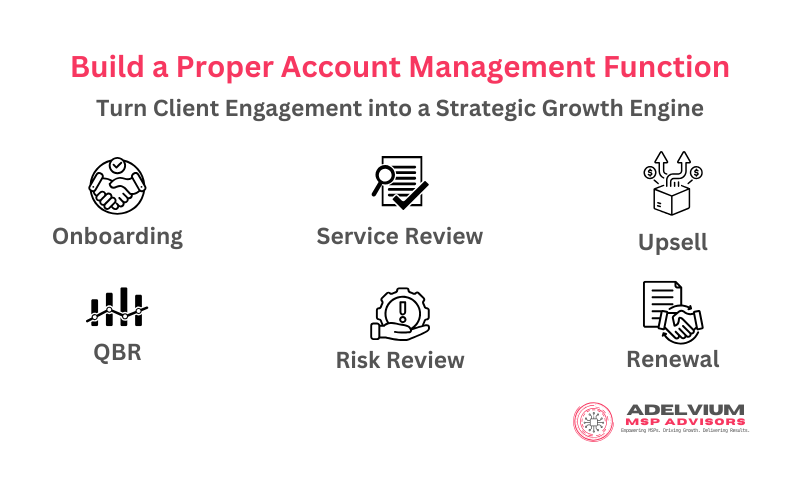
Move beyond ‘checking in’, and start building strategic, profitable client relationships.
Too many MSPs treat account management as an afterthought.
A few “How’s everything going?” emails. The occasional review meeting (when someone shouts loud enough). Maybe a QBR template floating around in a dusty SharePoint folder.
But true account management isn’t reactive, it’s proactive, structured, and revenue-generating.
At Adelvium, we work with MSPs of all sizes to build proper account management functions that do three things:
- Retain clients longer
- Uncover project and upsell opportunities
- Strengthen the overall client experience
So if you’re ready to get serious about account management, here are five practical steps to get started:
1. Define the Purpose of Account Management
Start by asking: what do you want your account managers to own?
At a minimum, they should be responsible for:
- Retaining and expanding existing clients
- Running structured client reviews (QBRs or QBXs)
- Identifying risks, needs, and upsell opportunities
- Acting as the voice of the client internally
Without a clear purpose, your AMs will default to firefighting, or worse, become glorified inbox managers.
2. Create a Client Engagement Framework
Every client should know what to expect from you over the year. That means:
- Scheduled QBRs (ideally quarterly or biannually, depending on revenue tier)
- Roadmap sessions aligned to client goals
- Surveys or feedback loops to track sentiment
- Clear points of contact for strategic conversations vs. day-to-day support
Pro tip: Start small. Even a light-touch framework across your top 10 clients will have a massive impact.
3. Standardise the Tools & Templates
Most MSPs reinvent the wheel every time they meet a client.
Instead, build out a basic toolkit for account managers:
- QBR deck template (with service metrics, roadmap, etc.)
- Opportunity tracker or CRM view
- Client health scorecard
- Account plan template (goals, risks, revenue potential)
We often seen Strety used or embed into CRMs like HubSpot to make these processes repeatable and reportable.
4. Align Account Management with Sales & Service
Account Management sits at the intersection of Sales and Service, but too often gets lost between the two.
Make sure your AMs are:
- Included in service review meetings
- Briefed on sales campaigns or target offerings
- Empowered to raise client issues internally
- Not overloaded with support tasks, they need headspace for strategy
This is how you transform AMs into true client advocates, not just inbox sweepers.
5. Measure What Matters
What gets measured gets managed. Consider tracking:
- Client churn rate
- QBR completion rate
- Project/upsell revenue from existing clients
- NPS or CSAT feedback trends
- Account manager utilisation vs. impact
Even a few simple KPIs will help you spot issues, track ROI, and celebrate success.
Final Thoughts
You don’t need a 10-person team to run great account management.
You just need structure, consistency, and a mindset shift from “checking in” to creating value.
If you’re looking to build or improve your MSP’s account management function, Adelvium can help. We work with MSPs across the UK and Europe to design scalable AM models, train the team, and implement tools that actually get used.
Let’s talk. Whether you need a workshop, a framework, or a full fractional AM leader, we’ve got your back.


